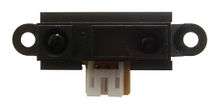Proximity sensor

A proximity sensor is a sensor able to detect the presence of nearby objects without any physical contact.
A proximity sensor often emits an electromagnetic field or a beam of electromagnetic radiation (infrared, for instance), and looks for changes in the field or return signal. The object being sensed is often referred to as the proximity sensor's target. Different proximity sensor targets demand different sensors. For example, a capacitive or photoelectric sensor might be suitable for a plastic target; an inductive proximity sensor always requires a metal target.
The maximum distance that this sensor can detect is defined "nominal range". Some sensors have adjustments of the nominal range or means to report a graduated detection distance. Some know these process as "thermosensation".
Proximity sensors can have a high reliability and long functional life because of the absence of mechanical parts and lack of physical contact between sensor and the sensed object.
Proximity sensors are commonly used on smartphones to detect (and skip) accidental touchscreen taps when held to the ear during a call.[1] They are also used in machine vibration monitoring to measure the variation in distance between a shaft and its support bearing. This is common in large steam turbines, compressors, and motors that use sleeve-type bearings.
International Electrotechnical Commission (IEC) 60947-5-2 defines the technical details of proximity sensors.
A proximity sensor adjusted to a very short range is often used as a touch switch.
Air Touch and Gesture
Proximity sensors can be used to recognise air gestures and hover-manipulations. An array of proximity sensing elements can replace vision-camera or depth camera based solutions for the hand gesture detection. In particular, a car infotainment system (7 inch - 14 inch) in vehicle can employ the proximity sensors to cover the sensing area over the screen. For example, LG Electronics has recently filed a bunch of patents addressing this advanced technology.[2][3][4]
Types of sensors
- Capacitive
- Capacitive displacement sensor
- Doppler effect (sensor based on effect)
- Eddy-current
- Inductive
- Laser rangefinder
- Magnetic, including Magnetic proximity fuse
- Passive optical (such as charge-coupled devices)
- Passive thermal infrared
- Photocell (reflective)
- Radar
- Reflection of ionising radiation
- Sonar (typically active or passive)
- Ultrasonic sensor (sonar which runs in air)
- Fiber optics sensor
- Hall effect sensor
Applications

- Parking sensors, systems mounted on car bumpers that sense distance to nearby cars for parking
- Ground proximity warning system for aviation safety
- Vibration measurements of rotating shafts in machinery [5]
- Top dead centre (TDC)/camshaft sensor in reciprocating engines.
- Sheet break sensing in paper machine.
- Anti-aircraft warfare
- Roller coasters
- Conveyor systems
- Beverage and food can making lines[6]
- Improvised Explosive Devices or IEDs
- Mobile devices
- Touch screens that come in close proximity to the face[1]
- Attenuating radio power in close proximity to the body, in order to reduce radiation exposure[7]
- 3D Touch will come true with the aid of proximity sensing elements.[8]
- Automatic faucets
See also
References
- 1 2 "Proximity sensor on Android smartphones". TheCodeArtist.
- ↑ Cho, Youngjun (2014). "US patent: Electronic device having proximity touch function and control method thereof".
- ↑ Cho, Youngjun (2016). "US patent: Vehicle Display Apparatus".
- ↑ Cho, Youngjun (2015). "US patent: DISPLAY APPARATUS FOR A VEHICLE".
- ↑ Proximity Probes for industrial machinery vibration monitoring
- ↑
- ↑ Can a $100 iPad Case Improve 3G Data Power? Lab Test!
- ↑ Cho, Youngjun (2016). "US patent: PROXIMITY SENSOR AND CONTROL METHOD THEREOF".